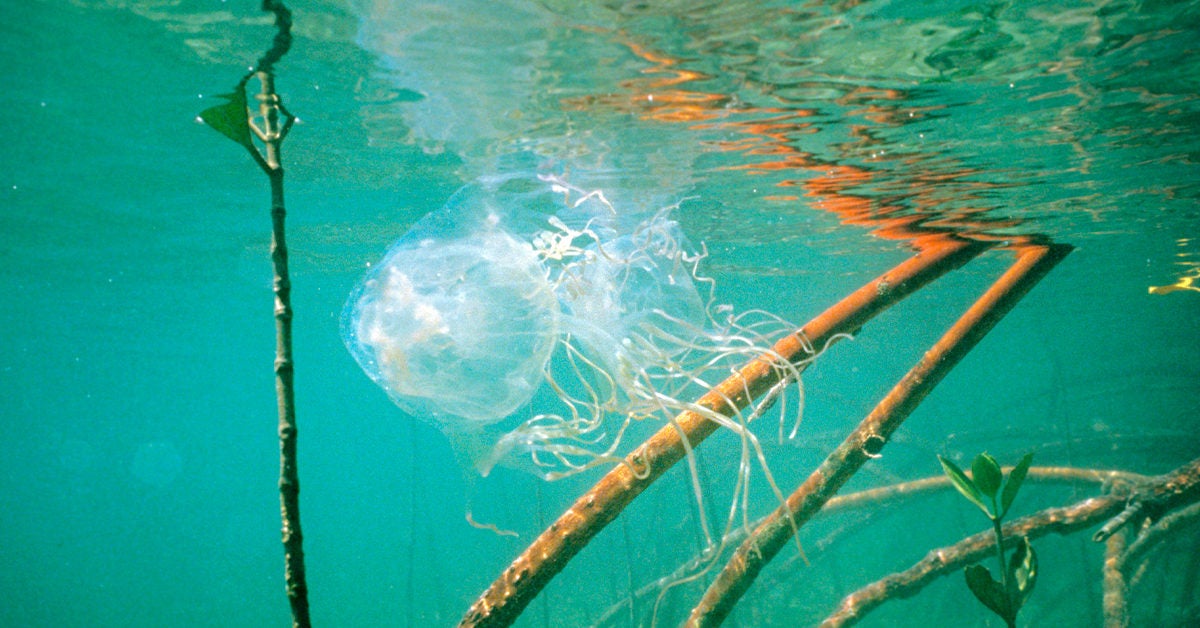Can box jellyfish hurt you?

Can a human survive a box jellyfish
Certain box jellyfish stings can kill a person within minutes. Other box jellyfish stings can lead to death in 4 to 48 hours after a sting due to "Irukandji syndrome," a delayed reaction to the sting.
How many humans can 1 box jellyfish kill
Each box jellyfish carries enough venom to kill more than 60 humans. A single sting to a human will cause necrosis of the skin, excruciating pain and, if the dose of venom is large enough, cardiac arrest and death within minutes.
Do box jellyfish hurt humans
Box jellyfish, named for their body shape, have tentacles covered in biological booby traps known as nematocysts – tiny darts loaded with poison. People and animals unfortunate enough to be injected with this poison may experience paralysis, cardiac arrest, and even death, all within a few minutes of being stung.
What happens if you touch a box jellyfish
The main symptoms and signs of a box jellyfish sting include: Burning pain in the skin. Welts in the skin, usually in a "whip" pattern. Tentacles from the jellyfish stuck onto the skin.
Do jellyfish feel pain
Jellyfish don't feel pain in the same way that humans would. They do not possess a brain, heart, bones or a respiratory system. They are 95% water and contain only a basic network of neurons that allow them to sense their environment.
Can dead jellyfish hurt you
The tentacles of the jellyfish have tiny stingers called nematocysts which can detach, stick to skin, and release venom. Even if the jellyfish is dead, it can still sting you because the cell structure of nematocysts is maintained long after death.
What is the most harmless jellyfish
Cannonball jellyfish are the most common jellyfish in our area, and fortunately, one of the least venomous. During the summer and fall, large numbers of this species appear near the coast and in the mouths of estuaries. Cannonball jellies have round white bells bordered below by a brown or purple band.
Do jellyfish chase you
MYTH #2: Jellyfish "go after" people
Not true. Any contact with jellyfish is incidental. Humans are not on their menu, but when we are in their environment we can get in the way of their tentacles.
Are jellyfish friendly to humans
Jellyfish stings can be painful to humans and sometimes very dangerous. But jellyfish don't purposely attack humans. Most stings occur when people accidentally touch a jellyfish, but if the sting is from a dangerous species, it can be deadly. Jellyfish digest their food very quickly.
Is it OK to touch the top of a jellyfish
The long tentacles of the jellyfish are what produce the sting. You can touch the top of the jellyfish without being hurt. Jellyfish come in white, blue, pink, yellow, green, purple, red and orange colors.
What jellyfish has the worst pain
Irukandji jellyfish's stings are so severe they can cause fatal brain hemorrhages and on average send 50-100 people to the hospital annually. Robert Drewe describes the sting as "100 times as potent as that of a cobra and 1,000 times stronger than a tarantula's".
What is the least painful jellyfish
Habu-Kurage and box jellyfish are known to have extremely painful stings, Japanese sea nettle are moderately painful, and moon jellyfish are pretty much painless.
Do jellyfish want to hurt you
Jellyfish don't mean to sting humans. But they can sting you when you brush up against them while swimming or walking along the beach. Most jellyfish stings are harmless. But some jellyfish stings can cause serious harm.
Is there a friendly jellyfish
The Aurelia Aurita, known as the moon jelly, is the most common and widely recognized jellyfish species. Though it has venom, it is harmless to humans—it's even a popular dish in China! The umbrella on the Aurelia Aurita can reach 30 to 40 centimeters, with marginal tentacles and gonads arranged in four circles.
What type of jellyfish never dies
hydrozoan Turritopsis dohrnii
The hydrozoan Turritopsis dohrnii, an animal about 4.5 millimetres wide and tall (likely making it smaller than the nail on your little finger), can actually reverse its life cycle. It has been dubbed the immortal jellyfish.
Are jellyfish friendly
Jellyfish stings can be painful to humans and sometimes very dangerous. But jellyfish don't purposely attack humans. Most stings occur when people accidentally touch a jellyfish, but if the sting is from a dangerous species, it can be deadly. Jellyfish digest their food very quickly.
Is it okay to hold a jellyfish
Never touch a jellyfish that's washed up on shore. Dead jellyfish still have venom in their tentacles that can sting on contact.
What is the safest jellyfish in the world
The Aurelia Aurita, known as the moon jelly, is the most common and widely recognized jellyfish species. Though it has venom, it is harmless to humans—it's even a popular dish in China!
What is the most safest jellyfish
Cannonballs are one of the most harmless jellyfish. They usually only cause minor itchiness or irritation when they sting humans, and they play an important role in the diets of leatherback sea turtles and humans.
Should I be scared of jellyfish
They're definitely no reason to fear the water! There are even a number of jellyfish that sting very mildly or do not sting at all, such as Pleurobrachia Bachei (more commonly known as sea gooseberries), or Aurelia Aurita (also called the moon jelly).
What are the kindest jellyfish
Pink Meanie Jellyfish
You will likely find this unique jelly off the coast of Florida, the Gulf of Mexico, the Caribbean, Atlantic, and Pacific oceans. Despite its name, the Pink Meanie is friendlier than other jellyfish. It feeds on its kind and can eat 34 at a time.
Do dead jellyfish hurt
Never touch a jellyfish that's washed up on shore. Dead jellyfish still have venom in their tentacles that can sting on contact.
What is the least toxic jellyfish
moon jellies
Jellyfish are invertebrates that use a form of jet propulsion to move through the water. They are famous – and feared — for their stinging cells, which they use to stun prey. However, moon jellies are the least dangerous jellyfish to humans.
Are some jellyfish friendly
Jellyfish are found in every ocean around the world and prefer to live in coastal areas. Some jellyfish are harmless to humans but others have venom that can be very deadly. The box jellyfish is one of the most venomous animals on the planet!
Do jellyfish suffer
Can jellyfish feel pain Jellyfish don't feel pain in the same way that humans would. They do not possess a brain, heart, bones or a respiratory system. They are 95% water and contain only a basic network of neurons that allow them to sense their environment.



0 Comments